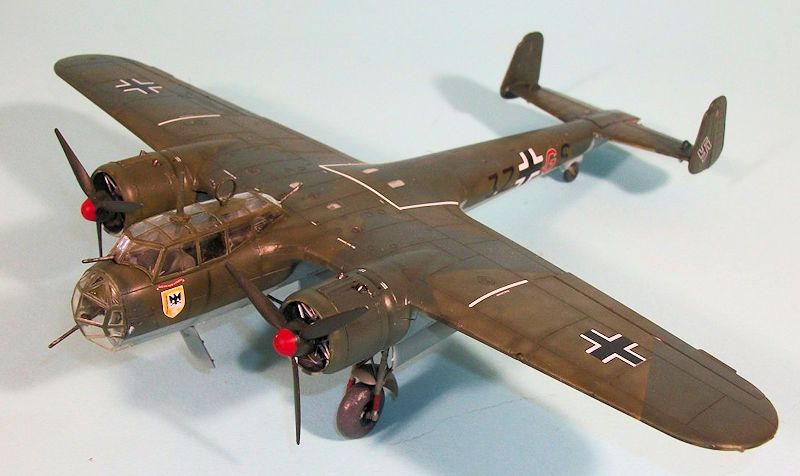
Airfix 1/72 Do-17Z
| KIT #: | A05010 |
| PRICE: | $26.99 SRP |
| DECALS: | Two options |
| REVIEWER: | Tom Cleaver |
| NOTES: | New tool (2015) |

| HISTORY |
The Dornier Do-17 series was referred to as the Fliegender Bleistift
("flying pencil"), due to its narrow fuselage.
The originally story about the origins of the Do-17 was that it was
designed as a fast mail plane with limited passenger-carrying capability, which
was originally a failure when it fist appeared, until a decision was made to
develop it as a Schnellbomber ("fast bomber"), a light bomber which
theoretically would be fast enough to outrun defending fighter aircraft.
In fact, when the decision was made to pursue development at the end of
1933, the RLM issued an order for a "high speed aircraft with
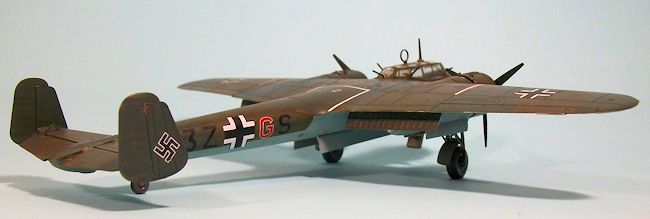 double tail,"
and for a "freight aircraft with special equipment," in other words, a bomber.
Following the public announcement of the existence of the Luftwaffe
in 1934, the design was specifically modified with proposed armament to become a
bomber.
double tail,"
and for a "freight aircraft with special equipment," in other words, a bomber.
Following the public announcement of the existence of the Luftwaffe
in 1934, the design was specifically modified with proposed armament to become a
bomber.
The original prototypes were powered by low-compression BMW VI 6.3
engines. The initial production
types, the Do-17E and Do-17F, were powered by the BMW VI 7.3D engines. Dornier
believed better performance could be obtained with high-powered engines.
What became the Do17M and Do-17P were powered with the Brama 323 Fafnir
engine, which gave
The "definitive" sub-type was the Do-17Z, which attempted to deal with the
problem of lack of power in the original sub-types.
The Do-17J was powered by the BMW 132F radial engine, which still did not
meet the original performance requirements.
What became the Do-17L and Do-17M used the DB 600 engine in their
prototype forms, with the Do-17M demonstrating a top speed of 264 mph at the
Zurich International Air Meet in 1937.
However, the need of the Daimler-Benz engines for fighters resulted in
the production Do-17M using the Bramo 323 radial, while the Do-17P used the BMW
132.
Following operational experience in Spain, the "definitive" Do-17 was
designed with a deeper nose that allowed better defensive armament to be
installed with a fourth crewman to operate the lower gun.
The changes in the roof and floor made the whole front of the aircraft
much larger, while the rest of the
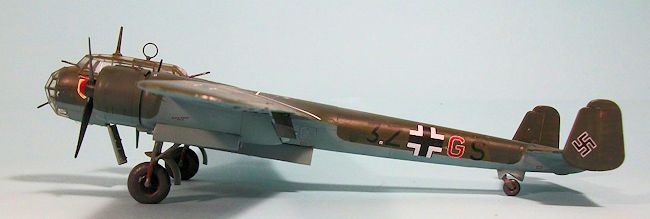 airframe
remained the same as before. The new cockpit design was nicknamed Kampfkopf
(German: "Battle head") While Dornier hoped to use the DB 601 engine, the
priority of the Bf-109 and Bf-110 for this powerplant led to continuing use of
the Bramo 323 series in what became the Do-17Z, which first appeared in 1938.
Using the Bramo 323P-1 engine providing 1,000h.p., the Do-17Z-2 was
capable of a top speed of 265 mph when lightly loaded, though its range was
short.
airframe
remained the same as before. The new cockpit design was nicknamed Kampfkopf
(German: "Battle head") While Dornier hoped to use the DB 601 engine, the
priority of the Bf-109 and Bf-110 for this powerplant led to continuing use of
the Bramo 323 series in what became the Do-17Z, which first appeared in 1938.
Using the Bramo 323P-1 engine providing 1,000h.p., the Do-17Z-2 was
capable of a top speed of 265 mph when lightly loaded, though its range was
short.
The Do-17Z appeared in squadron use in time to participate in the
invasion of Poland. During the
Battle of France, the short range of the bomber meant that it often was
sidelined while awaiting the capture of airfields closer to the front lines.
The airplane was popular with its crews for its speed which was only
bettered by the Ju-88, and its maneuverability, which was the best of any of the
early war German bombers at low altitude which resulted in the Do-17Z being
employed in the low-level bombing assault role.
By the time of the Western campaign, the Do-17Z was used by four
Luftwaffe bomb groups, KG 2, KG 3, KG 76 and KG 77.
The Do-17Z was the primary bomber used in the initial phase of the Battle
of Britain, the Channel attacks against British convoys in July and early
August. When the campaign extended
to Britain itself after August 15, the Do-17Z was used for low-level attacks
against RAF airfields in 11 Group.
While the airplane had been fast enough to almost live up to its name as a
Schnellbomber when opposed by the Poles, the Dutch, the Belgians and the French,
it met its match with the RAF Hurricanes and Spitfires, which were fast enough
to catch it at low level with increased losses.
After September 7, the bomber's low-level advantage became moot when the
Luftwaffe was ordered to bomb London from high altitude, and losses increased
even more. Famously, on September
15, "Battle of Britain Day," Do 17Z-2 Wk Nr.2361, coded F1+FH, of 1.Staffel/KG
76, flown by Robert Zehbe, was shot down with the main part of the wreckage
crashing into the forecourt of Victoria Station, eliciting a congratulatory
message to the
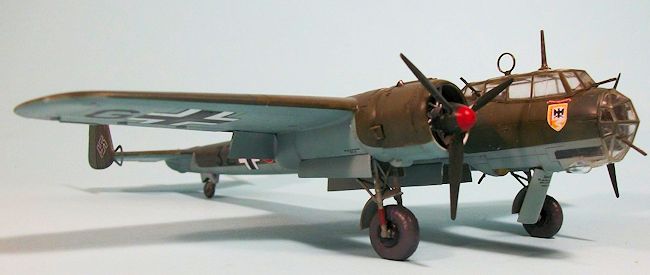 RAF from
Queen Wilhelmina of the Netherlands who witnessed the event.
RAF from
Queen Wilhelmina of the Netherlands who witnessed the event.
In August 1940, 54 Dorniers were lost with another 20 written off due to
technical problems and accidents. In September, 50 more were lost, with 31 Do
17Zs and crews missing in action. In October another 36 Dornier bombers were
lost. The Do 17's losses in the Battle of Britain were between 132 and 171, the
lowest losses as a ratio of the three German bomber types - the Do-17, He-111
and Ju-88. When the Luftwaffe
switched to night bombing, the Do-17 was withdrawn from operations in France
because of its light bomb load.
With the arrival of the Ju-88 in large numbers and the more powerful Do-217
about to enter service the following year, the days of the Do-17 were numbered.
When the Russian campaign began in June 1941, only KG2 was still fully
equipped with the Do-17Z, though staffeln of the other three
Kampfgruppen still used the type. Production ended in the summer of 1940 in
favor of the Do-217. 15 Do-17Zs
were provided to the Finns in 1941 and operated until 1945, while 20 were given
to the Croatian air force in 1944.
Small numbers of the Do-17Z were also modified as the Do-17Z Kauz night
fighter, where they were found to be inferior to the Ju-88C-6.
The last Do-17Z was scrapped in Finland in 1952.
On September 3, 2010, the Royal Air Force Museum in London announced the
discovery of a Henschel-built Dornier Do 17Z buried in the Goodwin Sands off the
coast of Kent, England. On June 10, 2013, the salvage team successfully raised
the airframe from the seabed and it is currently undergoing restoration at the
museum facility at Cosford.
| THE KIT |
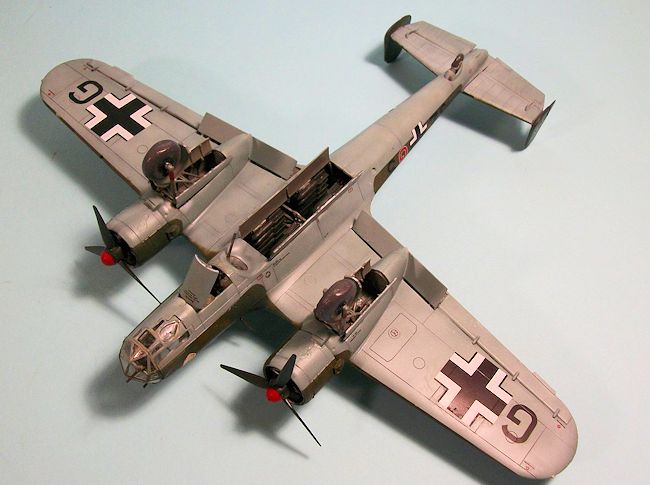
This new kit by Airfix continues the high standard that has been achieved
in the most recent Airfix releases.
The interior is fully detailed, with a complete cockpit, as well as a complete
bomb bay. The bomb bay is provided
all the different bomb and gas tank combinations used operationally, and can be
displayed open. The flaps are
separate and can be posed down. The
horizontal stabilizer, which could change its angle of attack, can be posed at
different angles. Decals are
provided for a Do-17Z of KG 77 in the summer of 1940 and a Do-17 used by the
Croats in 1944-45. All of the small
parts such as landing gear, machine guns, etc., are properly petite for the
scale.
| CONSTRUCTION |
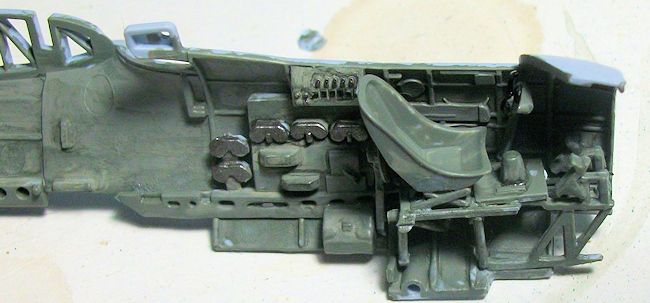 ers,
and really reduce problems in figuring out what goes where when.
ers,
and really reduce problems in figuring out what goes where when.
I began by painting all the cockpit interior parts, bomb bay parts, wheel
well doors, and landing gear with Xtracrylix RLM 02, which I then oversprayed
with thinned Tamiya "Smoke" to pop out detail.
I also painted the engine parts at this time and detailed them.
The detail provided in this kit is really astounding for 1/72 scale, and
is competitive with many 1/48 kits.
The clear parts are very clear, so all the effort put into the cockpit will be
seen.
The new Airfix kits feature quality molding.
If care is taken in assembly, you will not need seam filler anywhere.
Using the excellent instructions, I had the model assembled in an
afternoon.
| COLORS & MARKINGS |
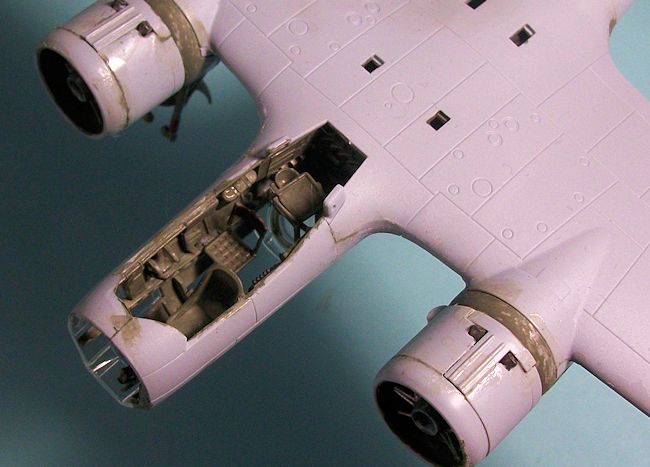 The model was pre-shaded, then painted in the standard Luftwaffe
camouflage of RLM 70/71 upper surfaces and RLM 65 lower surfaces.
Rather than freehand in this scale, I masked off the patterns with Tamiya
tape.
The model was pre-shaded, then painted in the standard Luftwaffe
camouflage of RLM 70/71 upper surfaces and RLM 65 lower surfaces.
Rather than freehand in this scale, I masked off the patterns with Tamiya
tape.
The kit sheet provides complete stenciling.
All the decals used reacted well to Micro-Sol and went down without a
problem. When everything was set, I
washed the model to get rid of any remaining solvent residue.
I gave everything a coat of Xtracrylix Flat varnish.
I then assembled and attached the landing gear, gear doors and bomb bay
doors. I detached the canopy and
nose cone, attached the machine guns in position and then glued these parts into
permanent location.
| CONCLUSIONS |
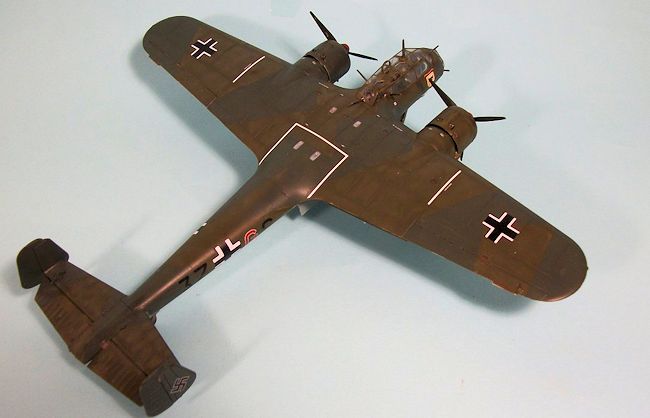 This kit is without a doubt the nicest, most accurate Dornier Do-17Z
available in any scale. Airfix
could scale this up to 1/48 without creating additional parts, and it would look
superb. The kit provides no
problems for anyone who has built a couple of models and is willing to take the
radical act of reading and following the instructions.
Airfix is definitely back!
This kit is without a doubt the nicest, most accurate Dornier Do-17Z
available in any scale. Airfix
could scale this up to 1/48 without creating additional parts, and it would look
superb. The kit provides no
problems for anyone who has built a couple of models and is willing to take the
radical act of reading and following the instructions.
Airfix is definitely back!
In closing, I'd like to thank my government-paid, bureaucrat-run, health
care system (aka the VA) for the cataract surgery last fall that changed my
right eye from 20/400 back to 20/20, thus giving me the visual acuity I haven't
had in 30 years, which has allowed me to re-discover the joys of 1/72 modeling,
just as Airfix has stepped up to release a slew of great new models in that
scale that will tempt anyone back to their modeling roots.
July 2015
Thanks to Hornby USA for the review kit.
If you would like your product reviewed fairly and fairly quickly, please contact the editor or see other details in the Note to Contributors.